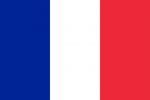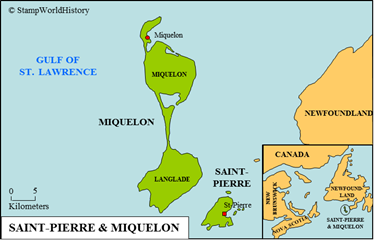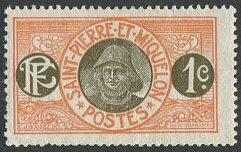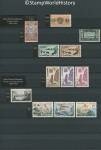
Saint-Pierre & Miquelon
Quick reference
General issues: French colony 1885-1946, French overseas territory 1946-1976, French territorial collectivity 1985-2003, French overseas collectivity 2003-Present
Country name on general issues: SPM, St-Pierre M-on, St-Pierre et Miquelon, Saint-Pierre et Miquelon
Currency: 1 Franc = 100 Centimes 1885-2001, 1 Euro = 100 Cents 2002-Present
Population: 6 400 in 1901, 6 080 in 2011
Political history Saint-Pierre & Miquelon
Saint-Pierre & Miquelon is a group of islands located in North America, off the coast of Newfoundland, Canada. Prior to colonization, Saint-Pierre & Miquelon would seem to have been uninhabited, although remains have been found of what would appear to have been temporary settlements of Amerindian peoples on seasonal hunting and fishing expeditions. The first Europeans to explore the islands were the Portuguese in 1520. In 1536, Saint-Pierre & Miquelon was claimed by France. Since then, Saint Pierre & Miquelon has been contested by France and Great Britain and changed hands several times. The islands were finally awarded to France in 1814 – the last remaining French possession in North America, all other possessions having been taken over by the British.
The French resettled the islands from 1816 – the settlers mainly being Basque, Breton and Norman fishermen. Fishery was developed as the main economic activity and brought a certain prosperity to the islands from the mid 19th century. However, in the 20th century fishery went into decline. Currently, Saint-Pierre & Miquelon is heavily subsidized by the French government – to stimulate the economy, fish farming, crab fishing, agriculture and tourism are developed.
Administratively, Saint-Pierre & Miquelon has been a French colony until 1946. During WWII, the local government was loyal to the Vichy regime in France – the Vichy regime collaborating with Germany. In 1941, the Free French, led by Charles de Gaulle, took over the islands. In 1946, Saint-Pierre & Miquelon became a French overseas territory and in 1976 a French overseas department. In 1985, the status of the islands was changed to that of a French territorial collectivity with a special status that gave the islands a larger amount of self government. Finally, Saint-Pierre & Miquelon became a French overseas collectivity in 2003.
The archipelago consists of two large inhabited islands – Saint-Pierre and Miquelon – and a number of smaller uninhabited islands. Saint-Pierre is the administrative and commercial center and is home to 90% of the population.
Postal history Saint-Pierre & Miquelon
The first stamps to be used on Saint-Pierre & Miquelon were the general issues for the French colonies from 1859. The first stamps issued specifically for Saint-Pierre & Miquelon appeared in 1885. These were the general issues for the French colonies overprinted ‘SPM’. In 1891, the overprint changed to ‘St-Pierre M-on’. The first definitives were issued in 1892 – stamps of the common ‘Navigation & Commerce’ design, inscribed ‘St-Pierre et Miquelon’. In the classical era, several large sets were issued with themes of local origin. Also, in the classical era, Saint-Pierre & Miquelon joined in several of the ‘Grands Series'[1]Omnibus issues for the French colonies.
In 1941, stamps were prepared by the Vichy regime in France for use on Saint-Pierre & Miquelon. As these were never put on sale, only the mint versions are listed. The Free French, in 1941, issued overprints reading ‘Noël 1941 – France Libre – F.N.F.L.'[2]‘F.N.F.L.’ stands for ‘Forces Navales Françaises Libres’, which translates to ‘Free French Naval Forces’. .
In the modern era, Saint-Pierre & Miquelon has had a limited stamp output, mainly with themes of national interest. Between 1976 and 1985 – as a French department – the stamps of metropolitan France were used.
Album pages
← Previous page: Saint VincentNext page: Sint Maarten →




